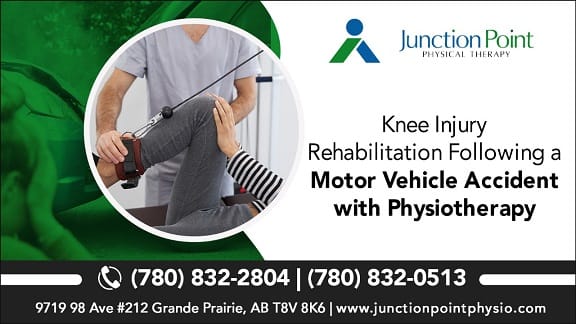Knee injuries are expected consequences of motor vehicle accidents(MVA), often resulting in significant pain, reduced mobility, and prolonged recovery periods. Proper rehabilitation is crucial to fully recovering and returning to normal activities. Consider motor vehicle accident physiotherapy Grande Prairie, which is vital in knee injury rehabilitation and offers tailored treatment plans.
Understanding Knee Injuries From Motor Vehicle Accidents
Motor vehicle accidents can lead to various knee injuries, including ligament tears (such as ACL or MCL tears), meniscus tears, fractures, and patellar dislocations. The impact forces in accidents can cause immediate damage to knee structures, leading to pain, swelling, instability, and limited range of motion. Early intervention prevents further complications and promotes effective healing.
The Role of Physiotherapy Techniques In Knee Injury Rehabilitation
Rehabilitating knee injuries involves a thorough approach to restoring function, strength, and mobility through motor vehicle accident physiotherapy in Grande Prairie. Here’s an in-depth look at the MVA physiotherapy techniques commonly used in knee injury rehabilitation:
Pain Management
- Heat Therapy: Heat therapy in knee rehabilitation involves applying heat to the injured knee to relax tight muscles, reduce discomfort, and improve flexibility by loosening stiffness and increasing blood flow, which aids healing.
- Cold Therapy: Cold therapy (cryotherapy) for knee injuries uses ice or cold packs to reduce inflammation by constricting blood vessels, numb pain for temporary relief, and alleviate muscle spasms and tightness around the knee.
- Electrical Stimulation: It applies electrical currents to the knee muscles to stimulate contractions. It helps maintain muscle strength and prevent atrophy, particularly when the knee is immobilized. It also blocks pain signals and promotes endorphin release to reduce pain.
Manual Therapy
Manual therapy in knee injury rehabilitation includes,
- Joint Mobilizations: Joint mobilizations controlled by a therapist who performs passive movements to stretch the knee joint and surrounding tissues can help improve range of motion, reduce stiffness, and alleviate pain by gradually increasing the joint’s mobility and promoting better function. This technique helps relieve stiffness, encourage blood flow, and normalize joint mechanics.
- Soft Tissue Mobilization: Massage techniques target the muscles, tendons, and ligaments around the knee to release muscle tension and promote relaxation. This approach alleviates tightness, supports healing, and aids in pain management and recovery.
Exercise Therapy
Strengthening exercises
Strengthening exercises are crucial for knee rehabilitation, as they build muscle strength around the knee to support and stabilize the joint.
- Leg Extension: The leg extension exercise is highly effective for targeting the quadriceps. Get seated on a leg extension machine with the back supported and feet secured under the pad. Extend the legs actively engage the quadriceps to lift the weight, enhancing knee extension and overall stability.
- Calf Raises: Calf raises are a powerful exercise for strengthening the calf muscles. While standing on the edge of a step with the heels hanging off, raise the heels to stand on the toes and then lower them back down. This exercise builds strength in the lower leg muscles, which supports knee function and improves gait.
Stretching exercises
Stretching exercises are crucial in knee rehabilitation for improving flexibility and reducing stiffness around the knee.
- Hamstring Stretch: Try sitting on the floor with one leg extended and the other getting bent. Reach the toes of the extended leg while keeping the back straight to stretch the back of the thigh. This exercise helps relieve knee tension and improve movement.
- Calf Stretch: The calf stretch involves placing one foot behind the individual with the heel on the ground and bending the front knee while keeping the back leg straight. This stretch improves flexibility in the lower leg and supports better knee function.
Functional exercises
Functional exercises in car accident physiotherapy mimic daily activities to improve practical movement and stability.
- Squats: To perform squats, stand with the feet shoulder-width apart, lower the body as if sitting in a chair, and return to standing. This exercise strengthens the muscles for climbing stairs and getting up from a chair.
- Lunges: To perform lunges, step forward with one leg, lower the hip until both knees form a 90-degree angle, and then push back to return to the starting position. This exercise enhances balance and stability.
If your rehabilitation journey involves setting up an accessible and comfortable space at home, using a reliable pool table movers service can assist with relocating heavy or bulky items safely.
Proprioceptive Training
Balance Exercises:
Balance exercises enhance coordination and stability in a knee injury rehab program. Balance boards are another effective tool for improving overall balance and coordination. Standing on an unstable surface forces the knee to engage stabilizing muscles and enhances coordination, which is essential for preventing falls and maintaining knee stability during various activities.
Dynamic Movements:
Agility drills focus on improving the knee’s ability to manage dynamic movements. Lateral shuffles involve moving side-to-side in a controlled manner, strengthening the muscles responsible for stabilizing the knee during lateral movements. This exercise is crucial for athletes and individuals who need to perform side-to-side movements in sports or daily activities, as it improves muscle strength and coordination around the knee, reducing the risk of injury.
Reassessments During Physiotherapy
The physical therapist will reassess the knee injury at each session to monitor progress, which may involve subtle observations of how the body responds to movements. Techniques for reassessment include evaluating the gait to observe improvements in the walking pattern and palpating the knee to detect abnormalities and assess pain.
Find The Path To Recovery From Knee Injury
Knee injury rehabilitation following a motor vehicle accident necessitates a comprehensive and personalized approach. Physiotherapy at Junction Point Physical Therapy in Grande Prairie provides practical solutions for restoring function. Their skilled physiotherapists specialize in motor vehicle accident physiotherapy Grande Prairie and help patients confidently return to daily activities.
Reaching out to Junction Point Physical Therapy is the first step towards recovery for those who have sustained a knee injury in a motor vehicle accident.
Read More: Accident With Physiotherapy

